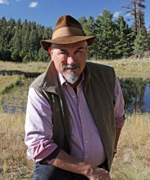 —by Alan Dulaney
—by Alan Dulaney
While in Flagstaff several days ago, I could see that the gardens were pulling back and the blooms were gone. Yellow tinges the aspen leaves on the upper slopes of the Peaks, and the grass has quit growing. There is a gathering chill in the morning air, and everything is turning more protective of its own interests. Winter is coming.
The Lower Basin Drought Contingency Plan (LBDCP) Steering Committee chaired by ADWR and CAWCD has evolved into a general forum in which committee reports are presented. While public, the meetings are informational summaries only. The real negotiations are happening in the various working groups, which are closed. Pinal County farmers would like all of the water loss under LBDCP to be fully mitigated, even though half of their irrigation water comes from wells. The Pinal agriculture working group has apparently agreed on the concept of full mitigation for 7 years and identified several mechanisms that could potentially bring water to that goal. The unnamed major sources for water for full mitigation appear to be cities and tribes. Yet no municipal or tribal government is likely to sign a 7-year waiver on water deliveries during a period of increasing uncertainty and risk. Plus, cities will need that water unencumbered for the next application cycle for their Designations of Assured Water Supply. They will protect their own interests.
Developers too are seeking full mitigation for CAGRD, which underlies new subdivisions’ Certificates of Assured Water Supply. Development is critical to Arizona’s economy. CAGRD relies on excess water for replenishment purposes, and excess water will be the first to be wiped out under LBDCP. This would be an added demand on whatever sources of mitigation water could be found.
Recently, articles have appeared that are cheerily optimistic about the progress of the Steering Committee. Tom Buschatzke (ADWR) and Ted Cooke (CAWCD) opined in the Arizona Republic that major progress was being made in the working groups. They said that everyone understood that they would have to give up water and money for the sake of LBDCP. But I don’t think the cities share that view.
Brenda Burman, Commissioner of the Bureau of Reclamation, is more cautiously optimistic. Speaking at the Water Educational Foundation’s Water Summit, she said that the various deals are still fragile. Her optimism is based on the fact that everyone recognizes that a declared shortage on the Colorado River will eventually impact all states, and that only a regional solution will work. And all states are indeed working towards the LBDCP solution, prodded by Reclamation.
In the current situation, we are blessed to have strong leaders like Tom, Ted, and Brenda who understand what has to be done to come up with a plan acceptable to all. Arizona has a long way to go and a short time to get there, and everyone on the Steering Committee appreciates that. Still, there is a chill in the air. Nothing is certain. And winter is coming.
NOTE: Alan Dulaney is running for the Board of Directors of CAWCD and will be on the Maricopa County ballot on November 6. Visit www.AlanDulaneyforCAWCD.com for more information.